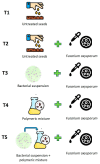Biopolymers as Seed-Coating Agent to Enhance Microbially Induced Tolerance of Barley to Phytopathogens
- PMID: 38337265
- PMCID: PMC10856975
- DOI: 10.3390/polym16030376
Biopolymers as Seed-Coating Agent to Enhance Microbially Induced Tolerance of Barley to Phytopathogens
Abstract
Infections of agricultural crops caused by pathogen ic fungi are among the most widespread and harmful, as they not only reduce the quantity of the harvest but also significantly deteriorate its quality. This study aims to develop unique seed-coating formulations incorporating biopolymers (polyhydroxyalkanoate and pullulan) and beneficial microorganisms for plant protection against phytopathogens. A microbial association of biocompatible endophytic bacteria has been created, including Pseudomonas flavescens D5, Bacillus aerophilus A2, Serratia proteamaculans B5, and Pseudomonas putida D7. These strains exhibited agronomically valuable properties: synthesis of the phytohormone IAA (from 45.2 to 69.2 µg mL-1), antagonistic activity against Fusarium oxysporum and Fusarium solani (growth inhibition zones from 1.8 to 3.0 cm), halotolerance (5-15% NaCl), and PHA production (2.77-4.54 g L-1). A pullulan synthesized by Aureobasidium pullulans C7 showed a low viscosity rate (from 395 Pa·s to 598 Pa·s) depending on the concentration of polysaccharide solutions. Therefore, at 8.0%, w/v concentration, viscosity virtually remained unchanged with increasing shear rate, indicating that it exhibits Newtonian flow behavior. The effectiveness of various antifungal seed coating formulations has been demonstrated to enhance the tolerance of barley plants to phytopathogens.
Keywords: beneficial microorganisms; biocontrol; dynamic viscosity; polyhydroxyalkanoate; polysaccharides; seed coating.
Conflict of interest statement
The authors declare no conflicts of interest.
Figures







Similar articles
-
Multifarious Plant Probiotic Features of Bacillus sp. W11 Isolated from Vermicast and Its Promises for Biocontrol Activity Against Phytopathogens.Appl Biochem Biotechnol. 2023 Jun;195(6):3615-3627. doi: 10.1007/s12010-022-04285-w. Epub 2023 Jan 17. Appl Biochem Biotechnol. 2023. PMID: 36648603
-
Cold-adapted strains as plant growth-promoting bacteria on soybean seeds and biocontrol agents against Macrophomina phaseolina.J Appl Microbiol. 2022 Nov;133(5):2835-2850. doi: 10.1111/jam.15759. Epub 2022 Aug 9. J Appl Microbiol. 2022. PMID: 35921041
-
Harnessing chickpea (Cicer arietinum L.) seed endophytes for enhancing plant growth attributes and bio-controlling against Fusarium sp.Microbiol Res. 2020 Aug;237:126469. doi: 10.1016/j.micres.2020.126469. Epub 2020 Mar 19. Microbiol Res. 2020. PMID: 32251977
-
The Use of Carbohydrate Biopolymers in Plant Protection against Pathogenic Fungi.Polymers (Basel). 2022 Jul 13;14(14):2854. doi: 10.3390/polym14142854. Polymers (Basel). 2022. PMID: 35890629 Free PMC article. Review.
-
Biocontrol of fungal phytopathogens by Bacillus pumilus.Front Microbiol. 2023 Jul 25;14:1194606. doi: 10.3389/fmicb.2023.1194606. eCollection 2023. Front Microbiol. 2023. PMID: 37560520 Free PMC article. Review.
Cited by
-
Regulation of photosynthetic characteristics carbon and nitrogen metabolism and growth of maize seedlings by graphene oxide coating.Sci Rep. 2025 Jan 22;15(1):2763. doi: 10.1038/s41598-025-87269-0. Sci Rep. 2025. PMID: 39843586 Free PMC article.
-
Silk Fibroin Seed Coatings: Towards Sustainable Seed Protection and Enhanced Growth.Polymers (Basel). 2024 Nov 25;16(23):3281. doi: 10.3390/polym16233281. Polymers (Basel). 2024. PMID: 39684026 Free PMC article.
-
Rhizosphere bacterial exopolysaccharides: composition, biosynthesis, and their potential applications.Arch Microbiol. 2024 Aug 28;206(9):388. doi: 10.1007/s00203-024-04113-1. Arch Microbiol. 2024. PMID: 39196410 Review.
-
Porous Biopolymer Matrices: Advanced Seed Delivery Platforms for Beneficial Microbes to Combat Soilborne Diseases.ACS Omega. 2025 May 11;10(20):20723-20731. doi: 10.1021/acsomega.5c01710. eCollection 2025 May 27. ACS Omega. 2025. PMID: 40454039 Free PMC article.
-
Machine Learning-Based Process Optimization in Biopolymer Manufacturing: A Review.Polymers (Basel). 2024 Nov 29;16(23):3368. doi: 10.3390/polym16233368. Polymers (Basel). 2024. PMID: 39684112 Free PMC article. Review.
References
-
- Xing K., Zhu X., Peng X., Qin S. Chitosan antimicrobial and eliciting properties for pest control in agriculture. Agron. Sustain. Dev. 2015;35:569. doi: 10.1007/s13593-014-0252-3. - DOI
Grants and funding
LinkOut - more resources
Full Text Sources
Miscellaneous

